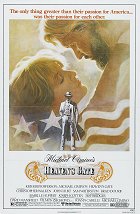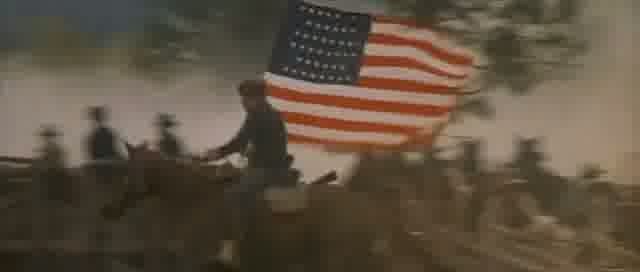Directed by:
Michael CiminoScreenplay:
Michael CiminoCinematography:
Vilmos ZsigmondComposer:
David MansfieldCast:
Kris Kristofferson, Christopher Walken, John Hurt, Sam Waterston, Brad Dourif, Isabelle Huppert, Joseph Cotten, Paul Koslo, Jeff Bridges, Geoffrey Lewis (more)VOD (2)
Plots(1)
This sprawling Western recounts the true story of Wyoming's Johnson County War. When wealthy cattlemen use brutal tactics to drive immigrant settlers of their land, Sheriff James Averill (Kris Kristofferson) intervenes. He clashes with -- and then befriends -- Nathan Champion (Christopher Walken), one of a group of armed mercenaries the cattlemen have hired to "solve" the immigrant problem. (official distributor synopsis)
(more)Reviews (4)
A film so epic, monstrously megalomaniacal and auteurishly stupid that it fills me with horror and admiration at the same time. After the Oscar harvest of The Deer Hunter, Cimino lost his judgement and took on the role of a filmmaker who can afford anything, regardless of cost and creative power, but at this point I, as a fan of the sensibly narrated, megalomaniac productions that were made especially in the 1950s and 60s, can only be pleased. This is the last Mohican of good old Hollywood, this is the film that made history, regardless of (or perhaps because of, depending on your point of view) the label of "the biggest movie flop of all time" (watching the Criterion Collection Blu-ray version, 219 min.).
()
The opposite side of the so-called New Hollywood: directors unleashed. Friedkin tormented the studio with a remake of The Wages of Fear, Coppola lived through his own private apocalypse with Apocalypse Now and Cimino wrecked himself and United Artists with Heaven’s Gate (one critic nicknamed it “Apocalypse Next” while the film was still in production). Did they make bad films? No, but under the influence of their own enormous egos, they failed to respect the unwritten rules of the game and contributed to shutting the door on a number of others. Of these three films, Heaven’s Gate, a 3.5-hour exhibition of talent directly from God, shows where the mistake was made. ___ Trouble hung in the air from the first days of filming. The plan called for shooting two pages of the 113-page screenplay per day. As it happened, approximately five-eighths of a page was shot daily. After twenty days, the filmmakers were ten days and 15 pages behind schedule (Tropic Thunder didn’t exaggerate so much). The budget gradually increased from the original ten million dollars to roughly forty million. All the way up to the premiere, studio representatives kept their cool, because they believed in the magic of the scenes that had been screened, which reminded them of David Lean in peak form. All optimism abandoned them with the first public screening of the uncut version (incidentally, Cimino had shot some 220 hours of material). It was a disaster. A shortened, 149-minute version was released to cinemas five months later. It made a very small difference; Heaven’s Gate earned 1.3 million dollars, which was a ridiculously small sum at the time it was made. An overlooked role in its failure was played by Ronald Reagan’s patriotic politics, with which the film’s critical content did not align. ___ The problem with the film is obvious from the opening minutes: it basically contains shots that are either needless or needlessly complicated. However, there is no denying that those shots look great. Vilmos Zsigmond’s brownish images do not lack flair, though the film is rather anti-western in its message. The expansive landscape, beautiful sky, light and shadow dictated by the movement of the clouds that you perceive. No kitsch, just divine patience. The wide screen is wide because of films like this. The comparison to David Lean works. ___ The question “where did the plot go?” is appropriate, but we could just as well (and just as inappropriately) ask the same question about Terrence Malick’s films. As Malick did in his later The New World, Cimino frequently focuses attention on the empty space between cause and effect, to which the setting of the story between two wars corresponds. Because America lives and breathes war, even if that means going to war against itself, this situation cannot last long. The captivating scenes when you wait to see what happens are captivating because of that waiting. There is tension, which is unjustified and thus all the more intense. The characters’ – probably unintended – insignificance and psychological flatness also make sense. Each of them attempts to survive with what they have and what they know how to do. Can these people reverse the course of history? What’s decisive is not what happens to them, but to the whole country. The sorrow over the treatment of the country is longer lasting. It doesn’t matter what happens, but how it looks. ___ The self-conscious positioning in the context of western films did not lead to the elimination of traditional western elements: the railroad, land, a harmonica, the Winchester Model 1866, rape, immigrants instead of Indians (who are recalled through a battle strikingly reminiscent of Little Bighorn – history constantly repeats itself). The active role of the female protagonist illustrates the expansion and modernisation of the thematic scope. Besides the rough masculine storyline, there is also a gentler feminine narrative line and the two of them brutally intersect on several occasions (rape first, shooting second). In the context of the time, the blatant nudity (not only of the non-American beauty Isabelle Huppert) can be seen as a reverberation of the sexual revolution. The film’s most critical subtext is provided by the academic prologue. In the pessimistic ending, we can pose the question that presents itself throughout the film – where has this “elite of the nation” actually led the nation over the course of more than twenty years? ___ The word “spectacular” does not describe the monumental sets very well. Everything seems believable; the artificiality of the old studio epics is gone, which is evidence that Cimino was distancing himself from them. The streets of the towns are lively, always populated by a crowd of extras making a lot of noise. There was apparently not only an abundance of money, but also of people. The face of a man who looks like Rasputin and a lady resembling the woman from Eisenstein’s Battleship Potemkin stand out from the jumble of nameless characters. Kris Kristofferson’s beard brings to mind General Custer (Little Bighorn again), which is perhaps the best thing I can ascribe to him, given the paltry opportunities he was given to display his acting talent. But individual life stories are not what the film is about, as it goes beyond the personal. ___ Regardless of how tense filming was, those involved in it sometimes give the impression that they rather spontaneously enjoyed it (the long dance sequence). It’s much more difficult for the viewer because Heaven’s Gate is not an audience-friendly spectacle. After three and a half hours of captivity, you start to see any film in a more favourable light, and this one ranks among the most visually captivating that Hollywood has ever given to the world. I want to believe that my next encounter with it will be friendly and my enthusiasm immediate. 90%
()
(less)
(more)
... or: How ego, ambition, an unknown actress in the leading female role and Slovak folk music bankrupted United Artists. It seems that over-populated is the only impression that remains with me. During the first thirty minutes so many (absolutely unnecessary) extras promenading around that even Bondarchuk would balk at it. I was afraid that even the intimate scenes would have a couple of hundred actors rolling around in the bed. For all that, the end result isn’t wrecked so much by Cimino’s flamboyant megalomania as by the pure fact that it hid a good genre-subverting hundred-minute movie into a filler-packed, almost four-hour lump of celluloid where he forgot to develop the main trio of characters.
()
Should a film be extolled only because its creator reached inhuman levels of perfectionism and every frame represents the most sophisticated aspects of narrative cinematography? If so, Heaven’s Gate deserves not five, but ten stars. But movies are also subject to a more complex way of communicating with the viewer and I wasn’t always happy watching three and a half hours of poorly portrayed characters twirling on dance floors and the American West, and a love triangle without any emotional basis. The motif of the circle, in which the film wanders throughout (and literally so in the final battle), generates an inimitable feeling of anti-western about the decay of the American dream and the blind journey towards a better future, where Cimino brilliantly demonstrates the immortal power of “Lean’s” pictorial expression – I was often genuinely captivated by the complex structure of the lively mise-en-scène and the framing of static images. Heaven’s Gate is a work of art, but one that produces in the viewer a response similar to an overpriced painting in a gallery: after a while it pisses you off that you can’t have it or touch it. The film has many passages that deserve to be framed and stored in a vault, but also lots of scenes that don’t make much sense and are so long that even a gallery would turn them off before they ended. It is a remarkable film and the last of its kind, but when compared with the similarly genre subversive Once Upon a Time in the West, it’s quite shabby and, unlike Leone’s masterpiece, I don’t think I would like to watch it again. 75%
()

